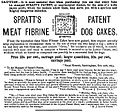Dog biscuit: Difference between revisions
CSV import Tags: mobile edit mobile web edit |
CSV import |
||
| Line 40: | Line 40: | ||
[[Category:Pet foods]] | [[Category:Pet foods]] | ||
{{nutrition-stub}} | {{nutrition-stub}} | ||
<gallery> | |||
File:A_Dog_biscuit.jpg|Dog biscuit | |||
File:1867_ad_for_Spratts_dog_food.jpg|1867 ad for Spratt's dog food | |||
File:1876_ad_for_Spratt's_Patent_Meat_Fibrine_Dog_Cakes.jpg|1876 ad for Spratt's Patent Meat Fibrine Dog Cakes | |||
File:Dog_with_treat.jpg|Dog with treat | |||
File:Maltoid_milk-bone.jpg|Maltoid milk-bone | |||
</gallery> | |||
Latest revision as of 04:57, 18 February 2025
Dog biscuit is a type of dog food specifically formulated and intended for consumption by dogs. These biscuits are often hard and dry. Dog biscuits are commonly used by dog owners for training purposes and as dietary supplements, contributing to the dog's oral health and nutrition.
History[edit]
The concept of the dog biscuit dates back to the mid-19th century when American electrician, James Spratt, went to London to sell lightning rods. After observing dogs being fed leftover biscuits from a ship, Spratt formulated the first dog biscuit: a mix of wheat meals, vegetables, beetroot, and beef blood. His biscuits were a hit among British country gentlemen who used them to reward their hunting dogs. This marked the beginning of the commercial dog food industry.
Ingredients[edit]
Modern dog biscuits are manufactured using a variety of ingredients to ensure they are nutritious and appealing to dogs. Common ingredients include:
- Meat and meat by-products
- Grains such as wheat, corn, and barley
- Vitamins and minerals
- Fats and oils
- Fibers for digestive health
Some high-quality dog biscuits may also contain supplements like glucosamine for joint health, omega-3 fatty acids for a healthy coat, and antioxidants for immune support.
Types[edit]
There are several types of dog biscuits available in the market, catering to different dietary needs and preferences:
- Puppy biscuits: Specially formulated for young dogs with additional nutrients to support growth.
- Senior dog biscuits: Lower in calories and easier to chew, addressing the dietary needs of older dogs.
- Dental biscuits: Designed to reduce plaque and tartar build-up, promoting oral health.
- Hypoallergenic biscuits: Made without common allergens like wheat, corn, and soy for dogs with food sensitivities.
Benefits[edit]
Dog biscuits offer several benefits beyond being a tasty treat for dogs. They can:
- Help with dog training and behavior modification as a form of positive reinforcement.
- Promote dental health by reducing tartar and plaque build-up.
- Provide essential nutrients and supplements that may be missing from the dog's main diet.
- Serve as a convenient way to feed dogs while traveling or on the go.
Considerations[edit]
When choosing dog biscuits, it's important to consider:
- The dog's age, size, and dietary needs.
- The quality of ingredients and the presence of any fillers or artificial additives.
- The calorie content, especially for dogs that are overweight or have a low activity level.
Conclusion[edit]
Dog biscuits are a versatile and beneficial addition to a dog's diet. Whether used for training, as a dietary supplement, or simply as a treat, choosing the right type of biscuit can contribute to a dog's overall health and well-being.
-
Dog biscuit
-
1867 ad for Spratt's dog food
-
1876 ad for Spratt's Patent Meat Fibrine Dog Cakes
-
Dog with treat
-
Maltoid milk-bone





